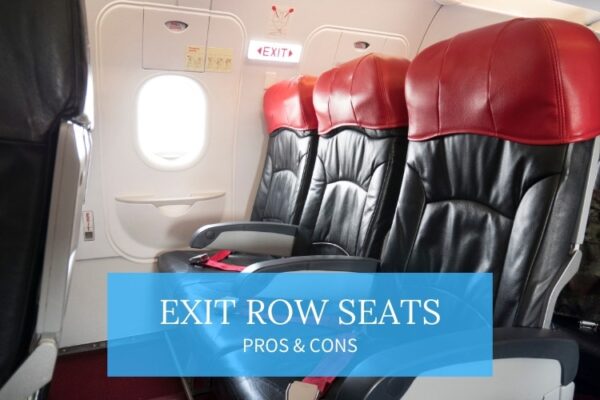Pros And Cons Of Aircraft Emergency Exit Row Seats
Emergency Exit Row Seat
In the past, before airlines began charging fees for some seat selections, travelers looking for some extra legroom could book the exit row seat. In exchange for that extra room, you had to listen to a flight attendant explain how to operate the exit row door in case of emergency. Knowing the odds of a plane actually crashing, it seemed like a pretty good deal.
But when airlines started charging fees for everything from baggage to ticket changes, many saw the chance to earn some money for that extra legroom, along with adding economy-plus seats at the front of the plane behind first/business class.
There are rules to sitting in the row outside of listening to the flight attendant’s instructions. You must be physically capable and willing to perform emergency actions when seated in emergency or exit rows, and you must be 15 years of age or older.
The biggest benefit of being seated in the emergency exit row is that the legroom is usually more generous, particularly on long-range aircraft. Smaller turboprops and regional jets tend to have a bit more room. But beware when booking these seats on larger narrowbody and widebody jets—you may get extra room, but your seat will not recline, which could affect your comfort on a longer flight.
Although not all airlines restrict the booking of exit row seating be forewarned—if you or someone you are traveling with falls under the restrictions placed on the emergency exit rows, you/they will be reseated. The inflight crew will not ignore safety procedures, which certainly does include whether a passenger should or shouldn’t be seated in the exit row.
So what passengers may be barred from sitting in an emergency exit row?
Children under 12 (sometimes up to 15) years old
Unaccompanied minors
Infants
Passengers with any physical or mental limitations that may affect a passenger’s ability to perform the functions required to remove the door and/or clear the path in the case of an emergency
Passengers traveling with a pet or service animal
Passengers who do not feel comfortable with the idea of performing the necessary duties in the case of an emergency
Passengers who do not speak any of the languages used by the crew on board (passengers in the exit row need to be able to understand safety instructions in the case of an emergency)
Passengers who have requested additional assistance from the airline, whether it be assistance to or from the aircraft, additional assistance on board, etc.
The extra legroom can almost make you forget that your elbows are snuggly planted against your rib cage, but the emergency exit row comes with restrictions. Make sure that you do not fall under those restrictions when you secure a seat in order to avoid the disappointment or frustration of being reseated.
Exit Seat Requirements
If you are seated in an exit seat and cannot meet the following selection criteria, cannot perform the necessary functions, believe that performing the functions may injure you, have a non-discernible condition that will prevent you from performing the applicable functions, or you do not wish to assist our crew in the event of an emergency, please ask to be reseated. Your reason for reseating need not be given.
Exit Seat Passengers Must:
Be at least 15 years of age and have the capacity to perform all of the applicable functions without the assistance of an adult companion, parent, or other relative;
Be able to read and understand instructions (in English) related to emergency evacuation as provided in printed or graphic form, and be able to understand oral crew commands (in English).
Be able to see well enough to perform the applicable functions without the assistance of visual aids beyond contact lenses or eyeglasses;
Be able to hear well enough to understand instructions shouted by flight attendants, without assistance beyond a hearing aid;
Be able to speak well enough to impart information orally to other passengers;
Not have a condition or responsibilities, such as caring for small children or animal that might prevent you from performing one or more of the applicable functions; or
Not have a condition that might cause the person harm if he or she performs one or more of these functions.
Exit Seat Requirements:
The person has sufficient mobility, strength, or dexterity in both arms and hands, and both legs:
To reach upward, sideways, and downward to the location of emergency exit and exit-slide operating mechanisms;
To grasp and push, pull, turn, or otherwise manipulate those mechanisms;
To push, shove, pull, or otherwise open emergency exits;
To lift out, hold, deposit on nearby seats, or maneuver over the seatbacks to the next row objects the size and weight of over-wing window exit doors;
To remove obstructions similar in size and weight to over-wing exit doors;
To reach the emergency exit expeditiously;
To maintain balance while removing obstructions;
To exit expeditiously;
To stabilize an escape slide after deployment; or
To assist others in getting off an escape slide.
Functions To Be Performed:
Locate the emergency exit;
Recognize the emergency exit opening mechanism;
Comprehend the instructions for operating the emergency exit;
Operate the emergency exit;
Assess whether opening the emergency exit will increase the hazards to which passengers may be exposed;
Follow oral directions and hand signals given by a crewmember;
Stow or secure the emergency exit door so that it will not impede use of the exit;
Assess the condition of an escape slide, activate the slide, and stabilize the slide after deployment to assist others in getting off the slide;
Pass expeditiously through the emergency exit; and
Assess, select, and follow a safe path away from the emergency exit.
Culled from Trip Savvy.








